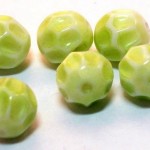
Wrinkled pea vs rounded pea and the important difference…
In the mid 1800’s, Gregor Mendel was a monk in a monastery in the city that is now called Brno in the Czech Republic. He grew peas in the monastery garden. Each variety of the peas he grew had distinct characteristics such has height, flower colour and shape but the one most people remember is the shape of the dried peas which could be either round or wrinkled. He had pure lines of round and wrinkled peas but when he crossed them he did not get intermediate shaped peas but three round peas to every wrinkled pea. From this, and many more crosses of his various lines of peas, he came to the conclusion that inherited characteristics were carried on units (now called genes) within the cell and some of these units were dominant in the cross i.e. the round variety whereas others i.e. the wrinkled were what we now call recessive.
 Mendel wrote his work up and had it published in 1866. It was totally ignored until the beginning of the 1900’s, when its significance was realized and the discipline of genetics founded. However, what was the gene that caused peas to be round or wrinkled? This was not solved until 1990 when a group of researchers at the John Innes Institute in Norwich, England, published a paper saying they had identified Mendel’s gene. This was 124 years after Mendel’s paper. It was a gene involved in building the structure of the starch molecule. In round peas the sugar that is taken up from the leaves is rapidly converted and packed into starch. Menel’s gene is involved in this process. The same gene in the wrinkled peas has become inactive which means that wrinkled peas cannot rapidly make compact starch molecules and the sugar solution in the seed is not used quickly. It is still present when the seed dries. This solution loses water and the seed shrinks and becomes wrinkled. The round seed is filled with starch and with no sugar solution it cannot shrink and remains round when dry. (However, we do like to eat sweet tasting peas…)
Mendel wrote his work up and had it published in 1866. It was totally ignored until the beginning of the 1900’s, when its significance was realized and the discipline of genetics founded. However, what was the gene that caused peas to be round or wrinkled? This was not solved until 1990 when a group of researchers at the John Innes Institute in Norwich, England, published a paper saying they had identified Mendel’s gene. This was 124 years after Mendel’s paper. It was a gene involved in building the structure of the starch molecule. In round peas the sugar that is taken up from the leaves is rapidly converted and packed into starch. Menel’s gene is involved in this process. The same gene in the wrinkled peas has become inactive which means that wrinkled peas cannot rapidly make compact starch molecules and the sugar solution in the seed is not used quickly. It is still present when the seed dries. This solution loses water and the seed shrinks and becomes wrinkled. The round seed is filled with starch and with no sugar solution it cannot shrink and remains round when dry. (However, we do like to eat sweet tasting peas…)
It needed modern molecular biology to identify Mendel’s gene. It would be possible now to take round seeds and, by using plant biotechnology, to modify the gene so that it produced an inactive enzyme which would produce Mendel’s wrinkled sweet seeds.